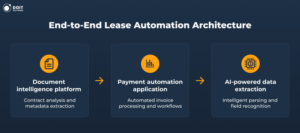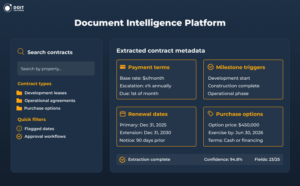The energy storage industry faces a unique operational challenge that most businesses never encounter. When you’re building massive battery installations to balance power grid demand, you need land – lots of it. However, securing hundreds of land parcels creates contract management issues that spreadsheets simply cannot handle.
In this case study, you’ll explore how automation developers tackled this exact challenge for a battery storage company managing over 600 land agreements. You’ll discover what land lease automation solutions have actually worked and how the right approach transformed manual contract management into a scalable operation. So, let’s get started!
This battery storage company operates in one of the most capital-intensive sectors of the energy industry. They build large-scale battery installations that serve as crucial infrastructure for grid stability. The main idea is to purchase electricity during low-demand periods and sell it back when prices spike.
This business model requires securing numerous plots of land through complex financial agreements. Each site represents a significant investment, and the company has accumulated over 600 land agreements across multiple states.
They involved intricate payment structures that changed based on development phases, construction milestones, operational periods, and various options or purchase terms.
The company’s contract management system consisted of:
This approach created several critical risks. First of all, human error became inevitable when managing hundreds of complex agreements manually. Additionally, missed payments could trigger contract breaches, potentially leading to the loss of valuable land rights.
And finally, the accounting team spent countless hours reconciling payments against contracts. Operations teams, in turn, struggled to track which agreements were approaching renewal dates or option exercise periods.
Moreover, the company’s growth trajectory made the existing system unsustainable. Adding new agreements meant increasing the manual workload, and the risk of errors grew with each new contract.

Process automation specialists addressed this challenge by developing a comprehensive lease automation system that encompassed every aspect of contract management. The solution focused on three core components:
Let’s take a further look!
The foundation of the lease automation solution started with centralizing all lease agreements in a single, searchable repository. Process automation experts built a document intelligence platform that standardized contract metadata across all 600+ agreements.

The platform extracted and organized key contract elements, including:
This centralization eliminated the fragmented spreadsheet approach and created a single source of truth for all contract data. The system automatically flagged contracts approaching critical dates. It also highlighted any discrepancies between contract terms and recorded payments.
The second stage involved building a custom application in Retool. The primary objective was to consolidate contract data and accounting information into a single, unified dashboard. This lease process automation tool created dynamic, rule-based payment schedules that adapted to each agreement’s unique structure.
For example, a typical agreement might start with $50,000 in annual payments during the development phase, escalate to $150,000 in monthly payments during construction, and then switch to a percentage-based revenue sharing once the facility becomes operational.
The system automatically calculated these transitions and generated payment schedules accordingly.
The application featured several key capabilities:
Users could now validate payments in minutes rather than hours. Moreover, the lease accounting automation system eliminated the manual reconciliation process that previously consumed entire team meetings.
In the third stage, process automation experts teamed with AI developers to leverage artificial intelligence for the most time-consuming aspect of contract management. They needed to extract structured data from unstructured agreements.
The automated contract data extraction system used built-in AI capabilities to identify and populate key contract fields automatically.
The AI component focused on:
The team also developed custom AI models specifically trained on land lease agreements to improve extraction accuracy. This lease agreement automation capability enabled new contracts to be processed and integrated into the system within hours.
As a result, the lease automation software transformed the company’s contract management capabilities. The most immediate impact was eliminating the dependency on manual spreadsheets and calendar reminders.
Also, process automation reduced monthly reconciliation meetings that previously consumed hours of team time. The accounting team now spends less on lease-related payment processing, freeing up resources for more strategic financial analysis.
Moreover, the system’s traceability features enabled comprehensive audit capabilities that satisfied both internal controls and external compliance requirements. Every payment decision and contract modification is now automatically logged with user attribution and timestamps.
Perhaps most importantly, the automated leasing system enabled true scalability. The company could now onboard new land agreements without increasing administrative overhead. As they expand into new markets, the system automatically adapts to different state regulations and contract structures.
All in all, lease automation is the future of contract-intensive industries. The digital transformation of contract management can bring significant changes to operations, making them more secure, efficient, scalable, and cost-effective.
If you would like to streamline your contract processes, you can get in touch with top process automation consultants who have years of experience and many successful implementations across various industries. Share your requirements, and DOIT will connect you with the right experts among data engineers, AI developers, or other automation specialists.










